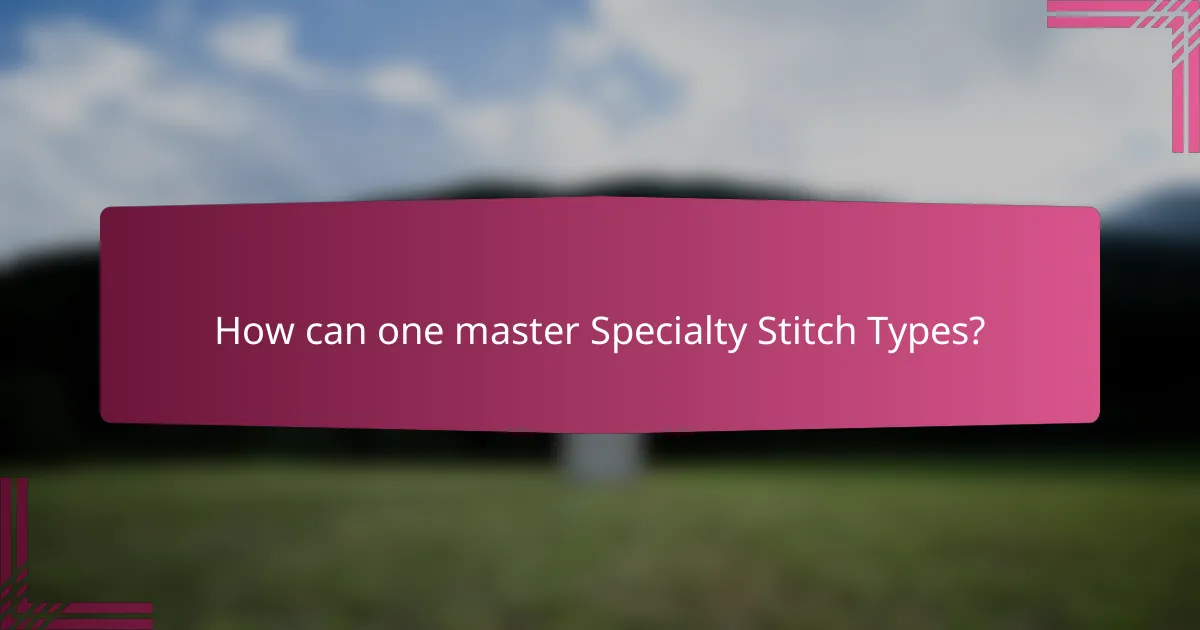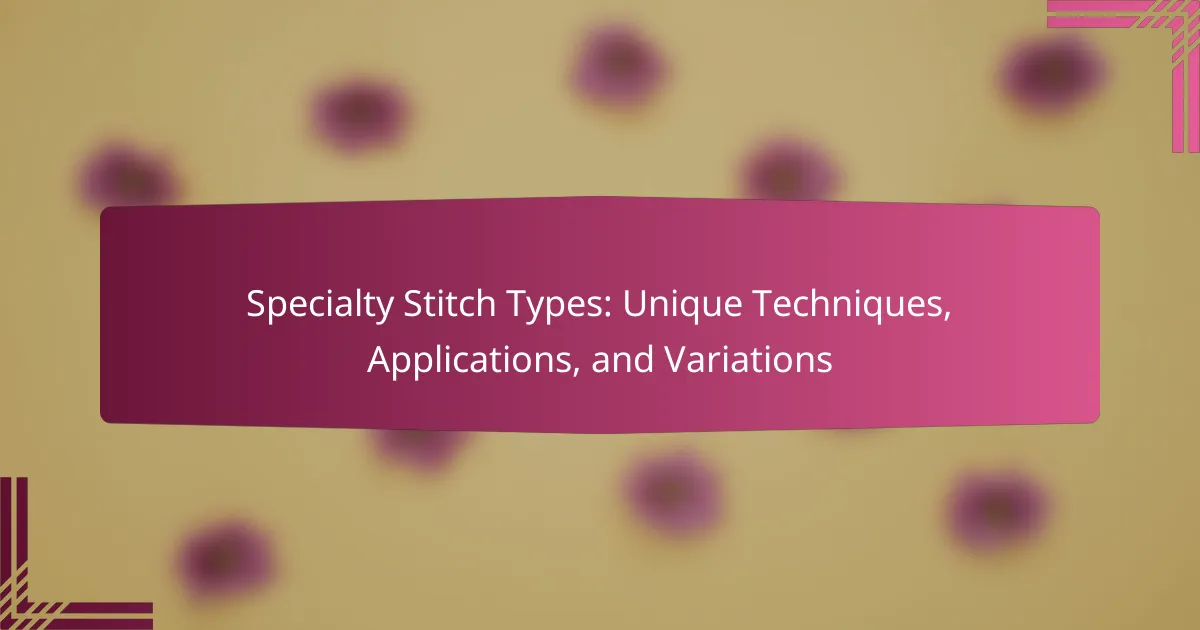
What are Specialty Stitch Types?
Specialty stitch types are unique sewing techniques that create distinct patterns and textures. These stitches go beyond standard sewing methods. They are often used in embroidery, quilting, and garment construction. Examples include satin stitch, cross stitch, and chain stitch. Each specialty stitch serves specific artistic or functional purposes. For instance, satin stitch provides a smooth finish on curved edges. Cross stitch forms a grid-like pattern, popular in decorative embroidery. Chain stitch creates a looped design, often used for outlining. These stitches enhance the visual appeal and durability of fabric projects.
How do Specialty Stitch Types differ from standard stitches?
Specialty stitch types differ from standard stitches primarily in their design and application. Standard stitches typically include basic forms like straight, zigzag, and satin stitches. Specialty stitches often incorporate unique techniques such as decorative patterns or multi-dimensional effects. For example, specialty stitches may involve techniques like French knots or smocking, which are not found in standard stitching. These stitches can enhance the texture and visual appeal of fabric. Additionally, specialty stitches are often used for specific purposes, such as embellishing garments or creating intricate designs. Their versatility allows for creative expression beyond the capabilities of standard stitches.
What are the defining characteristics of Specialty Stitch Types?
Specialty stitch types are unique embroidery techniques that create distinct patterns and textures. They include characteristics such as varying stitch lengths, thread types, and application methods. Specialty stitches often serve specific purposes, like adding dimensionality or decorative elements to fabric. Common examples include satin stitches, French knots, and chain stitches. Each type has its own set of rules for execution and design integration. For instance, satin stitches require closely spaced parallel stitches for a smooth finish. French knots create a raised, textured effect, ideal for embellishments. These characteristics set specialty stitch types apart from standard stitches, enhancing both functionality and aesthetic appeal in textile projects.
Why are Specialty Stitch Types important in sewing and embroidery?
Specialty stitch types are important in sewing and embroidery because they enhance the aesthetic and functional qualities of the fabric. These stitches allow for intricate designs that standard stitches cannot achieve. They enable the creation of texture, dimension, and detail in the finished project. For example, specialty stitches like satin stitch and French knots add uniqueness to embroidery patterns. Additionally, they can improve the durability of seams and embellishments. Research indicates that using varied stitch types can significantly impact the visual appeal of textile art. Therefore, specialty stitch types are essential for achieving both artistic expression and practical functionality in sewing and embroidery.
What unique techniques are associated with Specialty Stitch Types?
Specialty stitch types involve unique techniques such as the French knot, satin stitch, and cross-stitch. The French knot creates textured dots by wrapping the thread around the needle multiple times. Satin stitch fills shapes with smooth, flat stitches that give a polished look. Cross-stitch forms an ‘X’ pattern, allowing for detailed designs. Each technique serves specific applications in embroidery, enhancing visual appeal. Historical records show that these techniques have been used in various cultures for centuries, demonstrating their lasting significance in textile arts.
How are these techniques applied in different sewing projects?
Specialty stitch techniques are applied in various sewing projects to enhance design and functionality. Techniques like zigzag stitching create flexible seams on knit fabrics. They prevent fraying and allow for stretch, making them ideal for garments. Decorative stitches, such as scallops or waves, are often used in quilting projects to add visual interest. These stitches can also reinforce seams while offering aesthetic appeal. Techniques like topstitching provide durability and a polished finish on apparel. Each technique serves specific purposes across projects, from garment construction to home décor. The choice of technique depends on the fabric type and project requirements.
What tools are essential for executing Specialty Stitch Types?
Essential tools for executing specialty stitch types include specialized sewing machines, needles, and threads. A sewing machine with adjustable stitch settings allows for various specialty stitches. Needles designed for specific fabrics enhance stitch quality and precision. High-quality threads provide durability and a smooth finish. Scissors and seam rippers are necessary for clean edges and corrections. A measuring tape ensures accurate fabric dimensions. Finally, fabric stabilizers support intricate designs during stitching. These tools collectively enable successful execution of specialty stitch types.

What applications do Specialty Stitch Types have?
Specialty stitch types have various applications in textile arts and crafts. They are used for embellishing garments and home decor items. Specialty stitches enhance the aesthetic appeal of sewing projects. They can also provide structural support in specific fabric types. Techniques like satin, zigzag, and decorative stitches are commonly applied in quilting. Many specialty stitches are utilized in embroidery for intricate designs. These stitches allow for personalization in fashion and accessories. Additionally, specialty stitch types are essential in mending and repairing fabrics.
In which crafts are Specialty Stitch Types most commonly used?
Specialty Stitch Types are most commonly used in embroidery, quilting, and cross-stitch crafts. In embroidery, they enhance designs with texture and detail. Quilting benefits from these stitches for decorative patterns and durability. Cross-stitch utilizes specialty stitches to create intricate visuals and effects. These crafts often incorporate various techniques to achieve unique artistic expressions.
How do Specialty Stitch Types enhance the aesthetic of a project?
Specialty stitch types enhance the aesthetic of a project by adding unique visual elements. These stitches can create intricate designs and textures that standard stitches cannot achieve. For instance, specialty stitches like French knots or satin stitches introduce depth and dimension. They can also incorporate various colors and patterns, making projects more visually appealing. Additionally, these stitches can highlight specific areas, drawing attention to key features. The use of specialty stitches can elevate the overall craftsmanship of a piece. This enhancement is particularly evident in embroidery, quilting, and textile arts, where detail is crucial. Overall, specialty stitch types significantly contribute to the artistic expression in various projects.
What functional benefits do Specialty Stitch Types provide?
Specialty stitch types provide enhanced durability and aesthetic appeal in sewing projects. They are designed to serve specific functions such as reinforcing seams, adding decorative elements, and ensuring fabric stretch. For instance, zigzag stitches allow for fabric flexibility, making them ideal for knit materials. Specialty stitches like the flatlock stitch create a smooth finish, reducing bulk in seams. These stitches can also improve the structural integrity of garments, preventing fraying and wear. Additionally, specialty stitches can enhance the visual design of a project, creating unique patterns and textures. Their application varies across different fabrics and sewing techniques, making them versatile tools for crafters and manufacturers alike.
What variations exist within Specialty Stitch Types?
Variations within specialty stitch types include decorative stitches, functional stitches, and unique stitch techniques. Decorative stitches enhance the visual appeal of fabric. Examples are satin, zigzag, and blanket stitches. Functional stitches serve practical purposes, such as reinforcing seams. Examples include overlock and basting stitches. Unique stitch techniques may involve specific patterns or combinations, like smocking or heirloom stitching. Each variation serves distinct purposes in sewing and embroidery, catering to different aesthetic and functional needs.
How are these variations categorized by technique or application?
Variations of specialty stitch types are categorized by their specific techniques and applications. Techniques include embroidery, quilting, and decorative stitching. Each technique serves unique purposes. For example, embroidery is used for embellishing fabric. Quilting involves stitching layers of fabric together for warmth and design. Decorative stitching enhances the visual appeal of garments. Applications can vary from home decor to fashion design. Each category showcases distinct methods and intended uses. This categorization helps in understanding the versatility of specialty stitches.
What are some examples of popular Specialty Stitch Types and their uses?
Popular specialty stitch types include the chain stitch, satin stitch, and French knot. The chain stitch is used for outlining and creating decorative borders. It forms a series of loops that resemble a chain. The satin stitch is ideal for filling in shapes with a smooth finish. It is commonly used in embroidery to create solid areas of color. The French knot adds texture and dimension to designs. It is often used in floral motifs and to create small embellishments. Each stitch type serves specific decorative and functional purposes in various textile applications.

How can one master Specialty Stitch Types?
To master specialty stitch types, one must practice consistently and study various techniques. Begin by selecting a few specific stitch types to focus on. Utilize online resources or books that provide detailed instructions and visual aids. Joining a community or class can offer hands-on experience and feedback. Regular practice helps in developing muscle memory and precision. Experimenting with different fabrics and threads enhances understanding of each stitch’s application. Keeping a journal of progress and techniques can track improvement and challenges faced. Engaging with tutorials or instructional videos can provide additional insights and tips.
What resources are available for learning Specialty Stitch Types?
Books on embroidery techniques provide detailed instructions on specialty stitch types. Titles like “The Embroidery Stitch Bible” by Betty Barnden offer comprehensive guidance. Online platforms such as YouTube feature tutorials demonstrating various specialty stitches. Websites like Craftsy and Skillshare offer courses focused on specific stitch techniques. Local craft stores often host workshops on specialty stitching. Additionally, forums and social media groups connect learners with experienced stitchers for advice and tips. These resources collectively enhance understanding and mastery of specialty stitch types.
How can practice improve proficiency with Specialty Stitch Types?
Practice enhances proficiency with Specialty Stitch Types by allowing individuals to refine their techniques. Repeatedly executing these stitches builds muscle memory. It also increases familiarity with the unique characteristics of each stitch type. As individuals practice, they can identify and correct mistakes more effectively. This leads to improved accuracy and consistency in their work. Additionally, practice encourages experimentation with variations of each stitch. Engaging in regular practice can significantly shorten the learning curve. Studies in skill acquisition indicate that deliberate practice is essential for mastering complex tasks.
What tips should beginners consider when working with Specialty Stitch Types?
Beginners should start with basic specialty stitch types to build confidence. Familiarizing oneself with the tools and materials is essential. Practice on scrap fabric before working on final projects. Using clear instructions or tutorials can help understand the techniques. Keeping stitches uniform in tension is crucial for a polished look. Experimenting with different thread types can enhance the finished product. Lastly, patience is key; mastering specialty stitches takes time and practice.
What common mistakes should be avoided when using Specialty Stitch Types?
Common mistakes to avoid when using specialty stitch types include improper tension settings. Incorrect tension can lead to puckering or loose stitches. Another mistake is using the wrong needle type. A mismatch can cause skipped stitches or damage the fabric. Failing to practice on scrap fabric is also a common error. Testing on scraps helps to ensure the desired outcome. Additionally, not following the specific instructions for each stitch type can result in subpar results. Each specialty stitch has unique requirements for optimal execution. Lastly, neglecting to adjust the stitch length can affect the overall appearance. Proper adjustments are crucial for achieving the intended design.
Specialty stitch types are distinctive sewing techniques that create unique patterns and textures, often utilized in embroidery, quilting, and garment construction. This article explores the differences between specialty and standard stitches, highlighting their defining characteristics, importance, and various applications in textile arts. It also covers essential tools for execution, popular stitch types, and tips for mastering these techniques, including common mistakes to avoid. By understanding these elements, crafters can enhance the aesthetic and functional qualities of their sewing projects.
